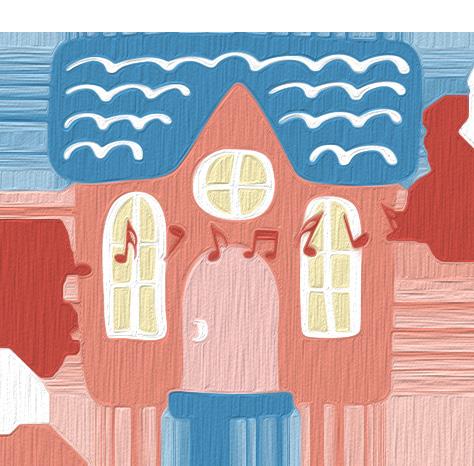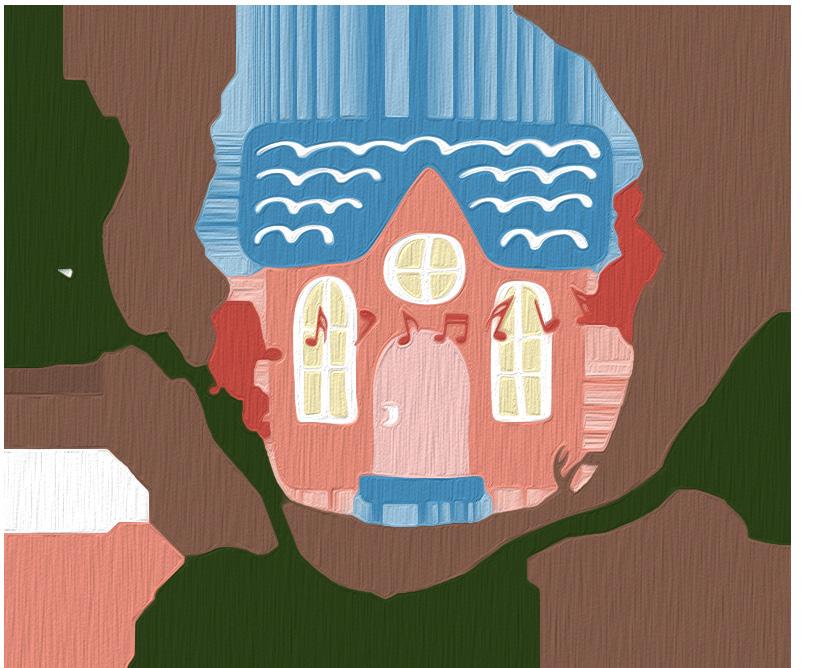
The Association of Latin American Students presents...
The Association of Latin American Students presents...


The Association of Latin American Students presents...
The Association of Latin American Students presents...


The word “Añoranza” is a spanish term that translates to “nostalgia” or “longing” in English. It refers to a sentimental or wistful yearning for something in the past, often associated with fond memories or experiences. It conveys a sense of missing or desiring something or someone that is no longer present.
Carnaval is the annual Latine cultural showcase at WashU. Through a variety of performances, our student cast and crew work to celebrate Latine culture on stage. Sponsored by the Association of Latin American Students, Carnaval represents a broad diaspora of Latine and Caribbean communities and, while we wish we could show you everything our culture has to offer, we hope that this selection does justice to the beauty and diversity that we come from. Whether you are here to celebrate your culture with us or to learn something new, we hope that you enjoy Carnaval 2024: Añoranza.
Thank you for attending Carnaval 2024: Añoranza. To honor our 25th anniversary, we’ve sought to make this year’s showcase unforgettable. Our student-run production is hosted by the Association of Latin American Students to celebrate our Latine and Caribbean community and its diversity.
Acknowledgements
Acknowledgements
A warm thank you to Emily Kennebeck, Jacob Goedde, Jamie Perkins, Tab Birt, Angel Recci, the 2023-2024 ALAS Executive Board, WashU Student Union, Edison Theater’s staff, our student tech crew, and our volunteer ushers for making this show possible.
We would also like to thank the Caribbean American Student Association and the friends and families that supported each of our performers along the way.








Bryanna Mendez: Co-Director
Melissa Villegas-Marin: Co-Director
Carlos Mendoza: Skit Co-Director
Veronica Lee: Skit Co-Director
Emily Feldstein: Assistant Director
Yoana Zamora Miranda: Philanthropy Chair
Lalo De Armas: PR Chair & Videographer
Juliana Gaztambide: Graphic Design Artist
Carlos Ramirez: Co-Choreo Liaison
Emily Martinez: Co-Choreo Liaison
To our Carnaval Committee, your enthusiasm and dedication has been essential to this year’s success. From chilly hours of underpass painting to our bonding moments at Lona’s Lil Eats, the energy this team has built has been the fuel to light up this show and continue to showcase our Latine community. We appreciate every single one of you and the ideas you’ve brought to make our 25th anniversary a memorable moment. Thank you.










Opening Speech
Scene 1
MERENGUE
Scene 2
FOLKLORICO
Scene 3
FLAG WALK
Scene 4
SENIOR DANCE
Scene 5
CHICANE BAND



Philanthrophy
CUBAN JAM SESH
Scene 6
CASA RED CARPET
Scene 7
SALSA
Scene 8
MARIACHI Scene 9
BOMBA
Closing Speech







As is WashU Carnaval tradition, skit is the foundation of the “Añoranza” show and theme. This year, our play centers a contentious theme familiar to many members of the Latin American community/ diaspora: reckoning with cultural and individual identity. We revisit a memory of our main character, Amparo (Ampi), as she flashes back to a night when she grappled with a life-changing decision amid the rare and precious setting that is a family party, where relatives living all over the country are coming together to celebrate her mother’s 50th birthday. Through moments of loving joy and clashing frustration, we get a glimpse into how each individual’s own dreams and experiences can move together and apart to shape the fabric of a family that we carry with us everywhere. The directors and cast hope that Ampi’s story will bring forth reflection and compassion in our community— for each other, for our families, and for ourselves— and maybe help us talk about feelings we tend to keep hidden in a neat little corner of our hearts.

Note: It is not specified at any point in the play the exact country where Ampi’s family originates from— don’t worry, you didn’t miss it. The directors made this decision to emphasize the pervasiveness of the experience that the characters face as Latin American immigrants in the United States.











Co-Writers and Directors:
Veronica Foureaux Lee and Carlos Mendoza
Actors:
Jeme Chavez as AMPI
Yuliana Hernandez as FLORENSIA
Luis Tinajero-Areola as DANI
Alejandro Santana as SERGIO
Andrew Breton as TIO
Emily Flores as THALIA
Kaín Sosa as DAVID
Sofia Angulo-Lopera as ABUELA
Rosalinda Nunez-Enriquez as TIA
Yael Rojo as AARON
Isaac Lendechy Olivares as CLERK











Merengue originated in the Dominican Republic and Haiti, with strong influences from Venezuela and AfroCuban traditions. Initially a folk dance dating back to the early 1800s, merengue stands out as one of the most liberated forms of dance in Latin America. The name is said to derive from a confection made of sugar and egg whites, reflecting the dance’s lively and airy nature. Today, merengue productions blend various music genres, which we feature in our routines. Our choreography encompasses traditional partner work, solo hip-hop and reggaeton elements, and classic circle formations. Ultimately, our aim is to inspire individuals to express their creative freedom through the art of dance.







Choreographers:
Emily Flores
Vlad Alarcon
Performers:
Emily Flores
Vlad Alarcon
Loren Lacruz
Kain Sosa
Alejandro Santana
Giselle Alcoser
Sofi Camargo
Ali Mora


Songs: Mujeriego
- Ryan Castro
La Dueña del Swing
- Los Hermanos Rosario Con El Pompi Pa’rriba
- Mala fe
Se Encendio el Beeper
- Oro Solido
Baile folklorico, directly translating to folkloric dance, describes a variety of traditional Mexican performance dances. Established around the 1950s in Mexico, folklorico developed as a result of mestizaje; the combination of Indigenous, African, and European cultures. Each state of Mexico has their own dance style with unique music, zapateado (footwork), and vestuarios (costumes).
This year, we are proud to represent both Guerrero and Veracruz! Characterized by Huipils (dresses), pañuelos (bandanas), and intricate 6/8 rhythms, Guerrero honors the indigenous Amuzgo people of the western coast of Mexico. On the opposite coast, the lacey white dresses, abanicos (fans), and bright string instruments distinguish the region of Veracruz. These two coastal states showcase elaborate zapateado (footwork) that compliment the music as live percussion. As we perform, we ask you to look and listen carefully for the zapateado, and welcome you to join us in our gritos and other cheers!
¡Que viva Mexico!








Choreographers:
Q Negrete
Danae Gaytán San Elias
Performers:
Valencia Alvarez
Alejandro Ballesteros
Bianca Calvillo
Jaquelin Cardenas-Lopez
Miranda Gamino-Ornelas
Danae Gaytán San Elias
Kayla Guzman
Kevin Lopez
Ja’lynn Maldonado
Q Negrete
Yair Rojo
Beecher Sanderson
Songs:
El Colas - Los Nacionales de Jacinto Gatica
La Chilena - Jose Manuel Figueroa
Flag Walk was born out of a desire to demonstrate the diversity and unity of countries in Latin America and the Caribbean. National pride is an enduring facet of life in both regions as relics from independence movements in the 19th and 20th centuries. Performers will showcase their pride by displaying their nations’ flags, wearing traditional clothing, and celebrating to music from their country. While not all of our performers have heritage from the country that they are repping, we strive to represent the grand majority of the countries that comprise Carnaval.
Choreographers:
Emily Feldstein
Bryanna Mendez
Yoana Zamora Miranda
Performers:
Jaquelín Cárdenas
Israel Chavez
Soraya Mejia Rosales
Carlos Ramirez
Sebastián Monge Reyes
Julianna Maria Torres
John Rivera
Gabriela Madriz
Emily Segura
Ian Gomez












Paul Rauschkolb
Camila Maneiro
Carlos Mendoza
Sofia Angulo Lopera
Maria Contreras
Vivian Robles-Pinos
Esther Perez
Allie Hoy
Ambar De Santos
Vlad Alarcon
Mariana Quiroz
Emily Feldstein
Yoana Zamora Miranda
Rodrigo Suárez López Gallo
Natalia León Díaz
Joharis Figueroa
Melina Marin
Añia Jacob
Alexandre Neptune
Christi Changoor

Alana Taylor
Ariel Elliott
Jesiree Fernandez
Andrew Breton
Christi Changoor
Alana Taylor
Ariel Elliott
Jesiree Fernandez
Andrew Breton


Senior dance is an opportunity for seniors across acts to give their farewell to Carnaval. This year’s senior dance takes the audience on a journey through the history of reggaeton, starting from the 1990’s. Seniors will bring figures throughout reggaeton to life onstage. All the songs are popular hits from the past up to the present, and we hope you dance along with us!
Choreographers:
Sofia Angulo-Lopera Loren Lacruz
Performers:
Carlos Mendoza as Daddy Yankee
Kain Sosa as Rauw Alejandro
Emily Flores as Kali Uchis
Bryanna Mendez as Young Miko
Yael Rojo as Bad Bunny

Isa Huesa as Shakira
Camila Maneiro as Natti Natasha
Yuliana Hernandez as Becky G
Ali Mora as Tokischa
Sofia Angulo-Lopera as Karol G




Songs: “Muchos Quieren
Tumbarme” - Ivy Queen
“Yo Voy” - Zion y Lennox
“Candy” - Plan B
“La Romana” - El Alfa
“Una Noche en Medellin” - Karol G
“Mercedes Carota”Bad Bunny





Chicano music, a vibrant and influential genre, has roots that trace back to the early 20th century. Emerging from the Mexican-American community in the United States, Chicano bands have blended elements of traditional Mexican music with various genres like rock, jazz, and blues, creating a distinctive sound that resonates with audiences worldwide. The history of Chicano bands is deeply intertwined with the struggles and triumphs of the Chicano civil rights movement. Artists like Ritchie Valens, Santana, and Los Lobos rose to prominence, infusing their music with themes of cultural identity, social justice, and resilience. Throughout the decades, Chicano bands have evolved, adapting to changing musical landscapes while staying true to their cultural heritage. From the soulful melodies of Tierra to the politically charged lyrics of Rage Against the Machine, Chicano bands have continued to push boundaries and challenge stereotypes, carving out a unique space in the music industry. Today, Chicano bands continue to thrive, with artists like Chicano Batman, Ozomatli, and Thee Sacred Souls carrying on the legacy of their predecessors while exploring new sonic territories. With their dynamic blend of rhythms and rich storytelling, Chicano bands remain a powerful force, celebrating diversity and inspiring generations to come.





Lead Director: Aldo Estrada
Singers:
Rosie Spratt
Wendy Chavez
Melissa Villegas-Marin



Instrumentalists:
Aldo Estrada
- Electric Bass Guitar
Sebastian Alamo Selis
- Piano
Aadit Ramesh
- Drums
Moises Akermam
- Guitar




Mission: St. Louis accompanies individuals in their path to selfsufficiency. By removing barriers to employment and education, we are fostering social and economic mobility for all people.
Through their initiative, HomeFirst, they transition people out of homelessness by providing safe, affordable apartments, helping establish and maintain employment, and giving access to wellness specialists. Empowering individuals will break cycles of poverty and instill the core sense of dignity that all of us share in them.
This year, Carnaval is proud to partner with Mission: St. Louis. In order to financially support this organization in its mission, we will be donating all proceeds from fundraising sales during intermission and ad sales in the program.
For more information on Mission: St. Louis, please visit https://www. missionstl.org/. For more details about HomeFirst, please visit https://www. missionstl.org/homefirst.



Donation Link: https://www.missionstl. org/donate









For the Cuban Jam Session act, we attempt to recreate the sound and feel of the Cuban descarga (“jam session”) genre, popularized in the 1950s and 60s. We chose to cover the song “Tito on Timbales” from Tito Puente’s 1978 album “Puente in Percussion.” The original song features a simple, repeating bass melody, which the percussionists jam upon and trade solos. Although the original track just featured a bass, timbales, congas, and bongos, we have decided to add a cowbell, jam block (clave), and güiro for a layered, dynamic sound. We hope you will enjoy our rendition of “Tito on Timbales.” We also hope our performance will inspire you to listen to more Cuban music from the era, such as the aforementioned descargas, mambo, rumba, and chá chá chá. ¡Habla!
Performers:
Leandro de Armas
– Cowbell
Hugo Córdova
– Congas (barril)
Aldo Estrada
– Electric Bass Guitar
Natalia León Díaz – Güiro
Alexandre Neptune – Jam Block (clave)
Aadit Ramesh – Bongos (played with sticks)














Our segment is a fashion showcase celebrating the vibrant Carnival costumes of Caribbean culture. This year, we draw inspiration from Jouvert morning festivities, a cherished tradition across many Caribbean nations where revelers adorned in paint, powder, and mud dance to the sweet rhythms of music. Throughout the semester, our talented students have dedicated themselves to designing costumes from scratch that reflect their diverse backgrounds across the Caribbean. As they grace the red carpet to songs that resonate with their heritage– from dembow and konpa to soca and beyond and – each costume tells a story of tradition, resilience, and pride. Join us as we celebrate the artistry, diversity, and unity of the Caribbean through the Carnival fashion that brings us together!










Choreographers: Zoe Mercado
Jessie Hillman
MCs:
Nyla Welch
Andrew Breton
Performers:
Ayana Loyd
Deborah Theophile
Dajana Pierre
Anthony Vidal, - Hijo de Yamaha
Alana Taylor
Marcelle Santana

Rovira
- El Vejigante
Rodery Gonzalez
Paris Robinson




Originating in Cuba during the 20th century, salsa is a Latin American dance shaped by different cultural tendencies from Spain, Africa, and the Caribbean. Before contemporary music, the beats of salsa were created using various instruments such as the clave, güiro, marimbula, congos, timbales, and cowbell. Today, traditional salsa songs such as Vivir mi Vida, Periódico de Ayer, and He Tratado by artists including Marc Anthony, Héctor Lavoe, and Víctor Manuelle incorporate these instruments and beats. Salsa dancing typically falls into one of two categories: social dancing or choreography. Social dancing is an improvisational form of salsa that usually occurs at clubs, reunions, parties, and more. Choreographed routines consist of movements set to music that are performed by salseros at competitions or showcases. With our choreography, we wanted to capture various essences of salsa, and to do so, we chose a traditional song for our first song, and more upbeat songs for our last two. Furthermore, we wanted to showcase a wide array of salsa dance styles throughout our piece by adding traditional, Central American, and reggaeton movements to our dance.







Choreographers:
Sebastián Monge Reyes
Irene Yuan
Performers:
Sebastián Monge Reyes
Kaylei Knight
Emily Feldstein
Jesiree Fernandez
Yoana Zamora Miranda
Isabella Caceres Ruscitti
Julián Villamil Rojas
Paul Rauschkolb
Maria Contreras
Carolina Dávila
Vlad Alarcon
John Rivera
Songs: Como lo Hacen - Frankie Ruíz
Es un Pecado - LKM
Que se Preparen - Los 4
Mariachi is a genre of regional Mexican music that originated in Western-Central Mexico in the 19th century. Mariachi bands include violins, trumpets, the guitar, the vihuela (small, gut-strung guitar with a soft, sweet sound), and the guitarrón (large bass guitar), sometimes including the harp. The different styles include boleros, huapangos, sones, rancheras, and valses. Musicians sing choruses in unison and take turns in the lead vocal role. Some well-known mariachi artists include: Vicente Fernandez, Juan Gabriel, José Alfredo Jiménez, Lola Beltrán, and Lucha Villa.
This year, we are excited to present a dynamic mariachi act. Our “modern mariachi” may not appear in the expected traditional mariachi attire, but we are sure that our heart, passion, and musicality will inspire you to listen with your ears, not your eyes. We invite you to pay close attention to the story that our repertoire tells. Our first song conveys the excitement of love that resonates the same way a cascabel would through continuous ringing. The next song takes a turn as the singer challenges the lover to explore the world and find a superior love. They promise to leave with the sun, as the evening dies into the night. Our last song leaves behind the unknown feelings and speaks of a pure love, made and destined only for them.


We hope our audience leaves with a greater understanding of the wide range of styles, tempos, and moods of music that mariachi music encompasses.


Directors:
Melissa Villegas-Marin
Gabriela Madriz
Musicians:
Melissa Villegas-Marin
- Violin
Gabriela Madriz
- Violin
Mariana Quiroz
- Violin
Jaqueline Marquez Salgado
- Violin
Elizabeth Murray
- Violin
Carlos Ramirez
- Trumpet
Kam Reo
- Guitar
Mario Chaires
- Guitar
Eder Carreon
- Guitarrón
Songs: El Cascabel
La Media Vuelta
Hermoso Cariño







Bomba, Puerto Rico’s first musical genre, descends directly from West African ancestors’ musical tradition in interaction with indigenous Taíno and Spanish influences. It originated more than 400 years ago during Puerto Rico’s Spanish colonial period. Bomba is deeply emotional, as it represents the lament of slaves in sugar plantations, who would congregate and utilize bomba music as a way to unveil their souls and create a space of communion and support between each other in light of the suffering they were forced to endure. Today, bomba continues to serve as a way to express the collective experiences, hardships, and dreams of all Puerto Ricans who live with the harmful consequences of colonialism and imperialism. There are various performers in bomba, namely, the dancers and musicians. The word “bomba” has its roots in a West African term for a drum. Therefore, the primary instruments in bomba music are the barriles (“barrels”), the drums played by the subidor, who musically accompanies the dancer’s movements, and the buleador, which maintains a steady rhythm. The two other traditional bomba instruments are the maracas and the cuá. One must imagine bomba as a dialogue or conversation between the dancer and the subidor, as the drummer responds to the dancer’s improvised piquetes, which are sharp and elegant movements of their skirt and body. The rhythms interpreted in this performance are Sicá, Cuembé, and Holandés, all of which originate from the Santurce neighborhood of San Juan.








Percussion Director: Hugo Córdova Olazábal
Choreographer: Natalia León Díaz
Dancers:
Jordana Brenes Vega
Zee Zee Covington
Hieran Andeberhan
Isabel Huesa
Alana Taylor
Marcelle Santana
Percussionists: Alexandre Neptune
Lalo de Armas
Aadit Ramesh
Aldo Estrada
Thank you for coming!
Thank you for coming!





Loved the music?
Check out our playlist!
Check out our playlist! Loved the music?
